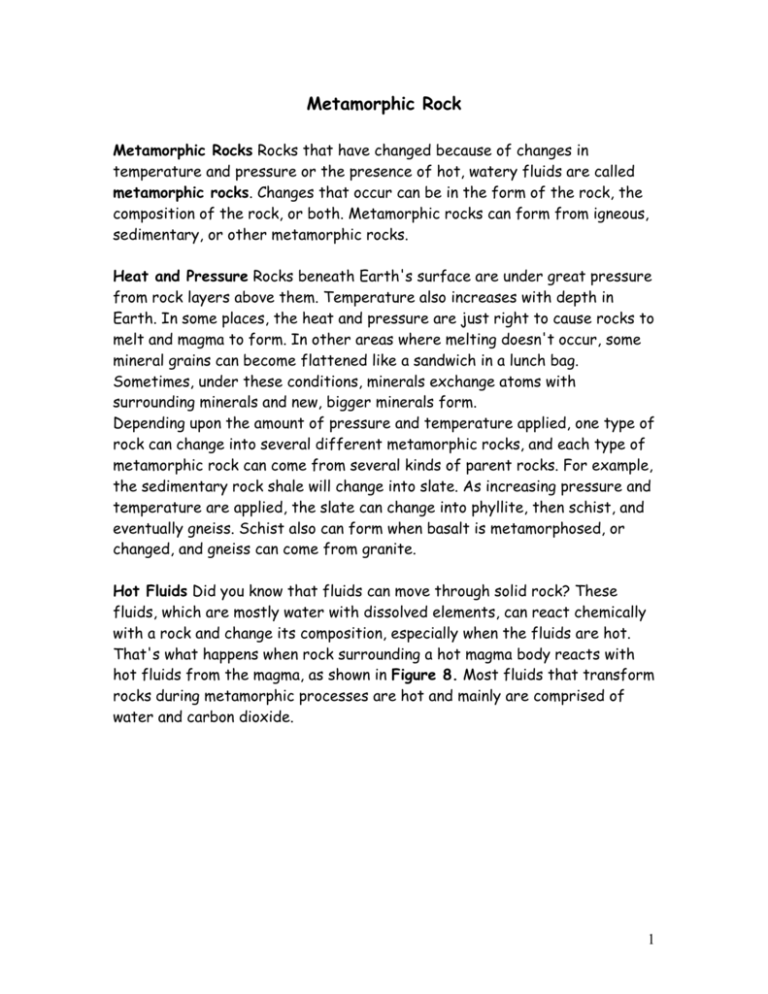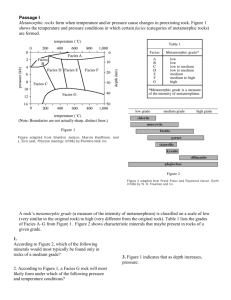Metamorphic Rock
advertisement

Metamorphic Rock Metamorphic Rocks Rocks that have changed because of changes in temperature and pressure or the presence of hot, watery fluids are called metamorphic rocks. Changes that occur can be in the form of the rock, the composition of the rock, or both. Metamorphic rocks can form from igneous, sedimentary, or other metamorphic rocks. Heat and Pressure Rocks beneath Earth's surface are under great pressure from rock layers above them. Temperature also increases with depth in Earth. In some places, the heat and pressure are just right to cause rocks to melt and magma to form. In other areas where melting doesn't occur, some mineral grains can become flattened like a sandwich in a lunch bag. Sometimes, under these conditions, minerals exchange atoms with surrounding minerals and new, bigger minerals form. Depending upon the amount of pressure and temperature applied, one type of rock can change into several different metamorphic rocks, and each type of metamorphic rock can come from several kinds of parent rocks. For example, the sedimentary rock shale will change into slate. As increasing pressure and temperature are applied, the slate can change into phyllite, then schist, and eventually gneiss. Schist also can form when basalt is metamorphosed, or changed, and gneiss can come from granite. Hot Fluids Did you know that fluids can move through solid rock? These fluids, which are mostly water with dissolved elements, can react chemically with a rock and change its composition, especially when the fluids are hot. That's what happens when rock surrounding a hot magma body reacts with hot fluids from the magma, as shown in Figure 8. Most fluids that transform rocks during metamorphic processes are hot and mainly are comprised of water and carbon dioxide. 1 Figure 8 In the presence of hot, water-rich fluids, solid rock can change in mineral composition without having to melt. Classifying Metamorphic Rocks Metamorphic rocks form from igneous, sedimentary, or other metamorphic rocks. Heat, pressure, and hot fluids trigger the changes. Each resulting rock can be classified according to its composition and texture. Foliated Rocks When mineral grains flatten and line up in parallel layers, the metamorphic rock is said to have a foliated or banded texture. Two examples of foliated rocks are slate and gneiss. Slate forms from the sedimentary rock shale. The minerals in shale arrange into layers when they are exposed to heat and pressure. Slate often is used as a building or landscaping material. The minerals in slate are pressed together so tightly that water can't pass between them easily. Because it's watertight, slate is ideal for paving around pools and patios. The naturally flat nature of slate and the fact that it splits easily make it useful for roofing and tiling many surfaces. Gneiss (NISE), another foliated rock, forms when granite and other rocks are changed. Quartz, feldspar, mica (MI kuh), and other minerals that make 2 up granite aren't changed much, but they arrange into alternating bands of light and dark minerals. Nonfoliated Rocks In some metamorphic rocks, layering does not occur. The mineral grains grow and rearrange, but they don't form layers. This process produces a nonfoliated texture. Sandstone is a sedimentary rock that's often composed mostly of quartz grains. When sandstone is heated under a lot of pressure, the grains of quartz grow in size and become interlocking, like the pieces of a jigsaw puzzle. The resulting rock is called quartzite. Marble is another nonfoliated metamorphic rock. Marble forms from the sedimentary rock limestone, which is composed of the mineral calcite. Usually, marble contains several other minerals besides calcite. For example, hornblende and serpentine give marble a black or greenish tone, whereas hematite makes it red. 3









